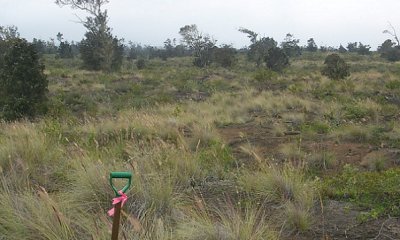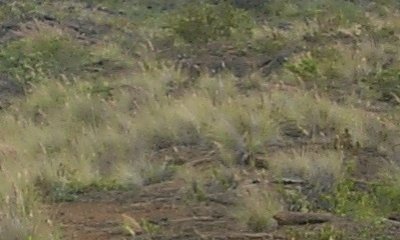
Dry Ustic Isomesic Shrubland
Scenario model
Current ecosystem state
Select a state
Management practices/drivers
Select a transition or restoration pathway
- Transition T1A More details
- Transition T1B More details
- Restoration pathway R2A More details
- Transition T2A More details
- Restoration pathway R3A More details
- Restoration pathway R3B More details
-
No transition or restoration pathway between the selected states has been described
Target ecosystem state
Select a state
State 1
Reference State




Description
This state consists of one community phase. Much of this ecological site is of marginal value as grazing land. Invasion by exotic grasses and forbs can change the species content of State 1 Reference without altering the general structure of the plant community, resulting in a transition to State 2 Invaded.
Invasion by silkoak (Grevillea robusta) and/or Cape ivy (Delairea odorata) has the eventual potential to radically alter the plant community. Invasion by introduced plant species such as those, together with loss of native species due to foraging by feral and/or domestic ungulates, results in State 3 Grazed and Browsed.
Submodel
Description
This state resembles the Reference state in general structure, but some native plant species have been lost or reduced in abundance. Introduced grasses have replaced native grasses to a great extent, native ferns are much reduced in abundance, and the forb category is greater in diversity, stature, and abundance.
If fountaingrass is abundant, the risk of wildfire is greatly increased. Silk oak may be invading and becoming abundant in some areas, particularly at lower elevations of the ecological site. Introduced vines can be very invasive, covering and killing other vegetation. Vines can be kept in check by sheep; however, sheep also graze and browse native vegetation.
Submodel
Description
This state consists of one community phase. It occurs when introduced plant invasion, increased wildfire, and/or ungulate foraging diminish the abundance of trees and shrubs. Native trees and shrubs are particularly vulnerable to these disturbances.
Submodel
Mechanism
This state transitions to State 2 Invaded by gradual invasion by introduced grasses and forbs.
Mechanism
This state transitions to State 3 Grazed and Browsed by reduction or loss of native species due to grazing and browsing by ungulates along with invasion by introduced plant species.
Mechanism
This state may be restored to State 1 Reference State by excluding all ungulates with a suitably designed fence. Spot weed removal must be done initially and maintained in the long term. Missing native plant species must be reintroduced.
Mechanism
State 2 Invaded can shift to State 3 Grazed and Browsed by frequent wildfires carried by introduced grasses. This is particularly true if fountaingrass (Pennisetum setaceum) has invaded the plant community in State 2. This transition due to fountaingrass invasion and subsequently increased wildfire has already occurred on areas of this ecological site near Puuwaawaa cinder cone at elevations between 3500 and 4000 feet (1080 to 1230 meters). Dense fountaingrass stands of limited extent exist at elevations as high as 5200 feet (1600 meters), and the species occurs currently up to 8000 feet (2460 meters).
Mechanism
It may be possible to return this state to a semblance of State 1 Reference. However, the dry climate, typically very shallow soils, and low abundance of native shrubs and trees would make this very difficult in most areas. Fencing, removal of all ungulates, intensive and long-term weed control, and replanting of native species would be required.
Mechanism
It may be possible to return this state to a semblance of State 2 Invaded. However, the dry climate, typically very shallow soils, and low abundance of native shrubs and trees would make this very difficult in most areas. Fencing, removal of all ungulates, intensive and long-term weed control, and replanting of native species would be required.
Model keys
Briefcase
Add ecological sites and Major Land Resource Areas to your briefcase by clicking on the briefcase (![]() ) icon wherever it occurs. Drag and drop items to reorder. Cookies are used to store briefcase items between browsing sessions. Because of this, the number of items that can be added to your briefcase is limited, and briefcase items added on one device and browser cannot be accessed from another device or browser. Users who do not wish to place cookies on their devices should not use the briefcase tool. Briefcase cookies serve no other purpose than described here and are deleted whenever browsing history is cleared.
) icon wherever it occurs. Drag and drop items to reorder. Cookies are used to store briefcase items between browsing sessions. Because of this, the number of items that can be added to your briefcase is limited, and briefcase items added on one device and browser cannot be accessed from another device or browser. Users who do not wish to place cookies on their devices should not use the briefcase tool. Briefcase cookies serve no other purpose than described here and are deleted whenever browsing history is cleared.
Ecological sites
Major Land Resource Areas
The Ecosystem Dynamics Interpretive Tool is an information system framework developed by the USDA-ARS Jornada Experimental Range, USDA Natural Resources Conservation Service, and New Mexico State University.




